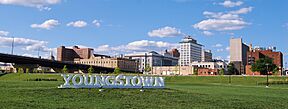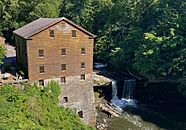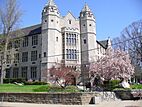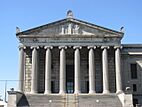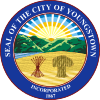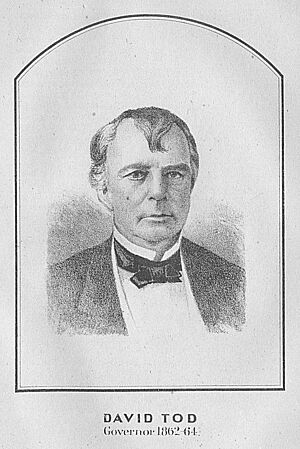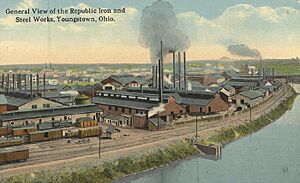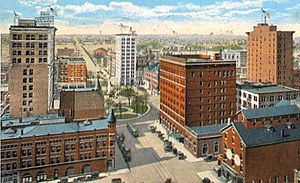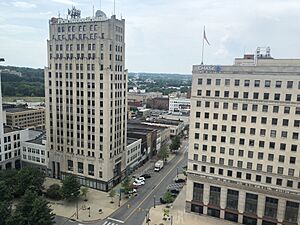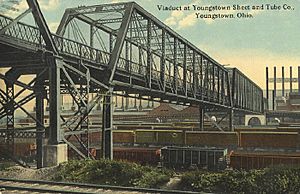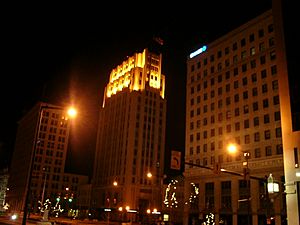Youngstown, Ohio facts for kids
Quick facts for kids
Youngstown
|
|||
|---|---|---|---|
|
Downtown Youngstown
Metropolitan Tower
|
|||
|
|||
| Nickname(s):
The City of You; The YO; Steel Town; Little Chicago; Y-Town
|
|||
| Country | |||
| State | |||
| County | Mahoning, Trumbull | ||
| Founded | 1796 | ||
| Incorporated | 1848 (village) | ||
| 1867 (city) | |||
| Founded by | John Young | ||
| Named for | John Young | ||
| Government | |||
| • Type | Mayor–council | ||
| • Body | Council of the City of Youngstown | ||
| Area | |||
| • City | 34.56 sq mi (89.52 km2) | ||
| • Land | 33.93 sq mi (87.87 km2) | ||
| • Water | 0.64 sq mi (1.64 km2) | ||
| Population
(2020)
|
|||
| • City | 60,068 | ||
| • Density | 1,770.40/sq mi (683.56/km2) | ||
| • Urban | 320,901 (US: 127th) | ||
| • Urban density | 1,637.6/sq mi (632.3/km2) | ||
| • Metro | 430,591 (US: 125th) | ||
| • CSA | 532,468 (US: 87th) | ||
| Demonym(s) | Youngstownian | ||
| Time zone | UTC−5 (Eastern Standard Time) | ||
| • Summer (DST) | UTC−4 (Eastern Daylight Time) | ||
| ZIP Code |
15 total ZIP Codes:
44501–44507, 44509–44515, 44555
|
||
| Area code | 330 and 234 | ||
| FIPS code | 39-88000 | ||
| GNIS feature ID | 1086573 | ||
Youngstown is a city in Ohio, United States. It is the main city of the Youngstown–Warren metropolitan area. In 2020, about 60,068 people lived there. This makes it the eleventh-largest city in Ohio. Youngstown is located on the Mahoning River in Northeast Ohio. It is about 58 miles (93 km) southeast of Cleveland. It is also 61 miles (98 km) northwest of Pittsburgh.
The city is named after John Young. He was an early settler who built the first sawmill and gristmill. Youngstown was a big industrial city in the late 1800s and early 1900s. It was famous for making steel. When the steel industry declined in the 1970s, many jobs were lost. This made Youngstown part of the "Rust Belt". Since 1960, the city's population has dropped by almost 65%.
Today, Downtown Youngstown is working to become new again. New places like the Covelli Centre and Youngstown Foundation Amphitheatre have opened. Other important spots include the Butler Institute of American Art, Mill Creek Park, Stambaugh Auditorium, and Youngstown State University. A new hotel, the DoubleTree by Hilton, opened in 2018. It was the first new downtown hotel since 1974.
Contents
History of Youngstown
How Youngstown Began
Youngstown is named after John Young from New York. He explored the area in 1796 and moved there soon after. On February 9, 1797, Young bought 15,560 acres (63 km²) of land. He paid $16,085 for it from the Western Reserve Land Company. Youngstown was officially started on August 19, 1802.
The land where Youngstown is now was part of the Connecticut Western Reserve. This was a section of the Northwest Territory. Many early settlers came from Connecticut. But Youngstown also attracted many Scots-Irish people from nearby Pennsylvania. The first European Americans to live there permanently were James Hillman and his wife Catherine Dougherty from Pittsburgh. By 1798, several families lived near where Mill Creek meets the Mahoning River.
As more people moved to the Western Reserve, new areas were needed. In 1800, Governor Arthur St. Clair created Trumbull County. He made Warren the main town, or county seat. In 1813, Trumbull County was divided into smaller areas called townships. Youngstown Township covered much of what became Mahoning County. Youngstown became a village in 1848. In 1867, it became a city. It became the county seat of Mahoning County in 1876. It has been the county seat ever since.
Growing with Industry
When coal was found in the early 1800s, Youngstown became part of the Erie Canal network. The Pennsylvania and Ohio Canal was finished in 1840. A local businessman, David Tod, convinced steamboat owners that coal from the Mahoning Valley could power their boats. This was possible if the canal connected Youngstown to Cleveland. The arrival of the railroad in 1856 helped the economy grow even more.
Youngstown's industrial growth changed the Mahoning Valley. The growing coal industry brought many immigrants from Wales, Germany, and Ireland. Later, when steel mills were built, people from Eastern Europe, Italy, and Greece came to Youngstown.
In the early 1900s, more immigrants arrived from countries like Lebanon, Israel, Palestine, and Syria. By the 1920s, some people in the area reacted negatively to these changes. The Ku Klux Klan became active in the Mahoning Valley. In 1924, there were fights between Klan members and Italian and Irish Americans in Niles. The Ohio Governor had to send in the military. By 1928, the Klan's power was much weaker.
The growth of industry also attracted people from other parts of the United States and Latin America. By the late 1800s, many African Americans lived in Youngstown. The first local African Methodist Episcopal Church was started in 1871. In the early 1900s, more African Americans moved to the city for factory jobs. During the Steel Strike of 1919, factory owners hired thousands of workers from the Southern United States, many of whom were Black. This caused racial tension. African-American steelworkers faced unfair treatment at work for many years. More people from the South moved in the 1940s. This happened when farming became more mechanized, ending the sharecropping system.
By the early 1900s, Youngstown's local iron ore was used up. Since the city is not on a major river or lake, ore from other states had to come by train. This made it more expensive for Youngstown's steel mills to get raw materials. This higher cost was one reason why Youngstown's mills started to decline earlier than those in other cities.
Youngstown had good transportation connections in the Midwest. An airport built in 1930 had flights to New York. The city was also on major train lines. These included the Baltimore and Ohio Railroad and the Erie Railroad.
After World War II: Changes and Challenges
After World War II, more people moved to Youngstown. The steel industry seemed strong, attracting thousands of workers. In the 1950s, the Latino population grew a lot. By the 1970s, churches like St. Rose of Lima Catholic Church served many Spanish-speaking residents. In 1951, city planners thought Youngstown would grow to 200,000-250,000 people. They expected high demand for steel. So, they added 12,000 acres (48.5 km²) to the city. They also planned for new housing and businesses.
The industrial economy that brought many groups to Youngstown collapsed in the late 1970s. On September 19, 1977, the Youngstown Sheet and Tube factory in Campbell closed. This day is known as "Black Monday." It was a major blow to the steel industry in Youngstown. The closure was due to changes in how steel was made and competition from other countries. After the steel plants closed, the community lost about 40,000 factory jobs. Many other businesses also closed. Youngstown has been working to recover from these job losses.
Modern Developments in Youngstown

Downtown Youngstown has seen some new buildings. In the 2000s, new additions included the Nathaniel R. Jones Federal Building and U.S. Courthouse in 2002. The Mahoning County Children's Services Center and George Voinovich Government Center opened in 2004. The Covelli Centre and Ohio Seventh District Court of Appeals opened in 2006.
In 2004, a new housing development called Arlington Heights began. It had 60 upscale homes. An old public housing project, Westlake Terrace, was torn down. Now, that site has housing for seniors, rental townhouses, and homes for sale. Low real estate prices and efforts by the Youngstown Central Area Improvement Corporation have helped. Many old downtown buildings have been bought and fixed up. They are now shops, restaurants, and apartments. Also, a $250 million project called New Urbanist revitalization happened in the Smoky Hollow neighborhood. It added about 400 new homes, student housing, shops, and a park.
In 2005, Federal Street, a main downtown road, reopened to traffic. It had been closed to create a walking area. Old buildings have been torn down, and others have been expanded or restored. New construction has helped businesses grow. The Youngstown Business Incubator (YBI) has been very successful. It helps new technology companies by giving them office space and support. Some companies from the Incubator have become very successful.
The city government and Youngstown State University created a plan called Youngstown 2010. This plan aims to make Youngstown "cleaner, greener, and better planned." The plan accepted that the city's population would be smaller. It focused on improving the city's image and quality of life. This plan has received national attention.
On May 28, 2024, an explosion damaged the Realty Building downtown. One person died and seven were injured. It was thought to be caused by a natural gas leak.
Geography and Climate
Youngstown's Location

Youngstown covers about 34.60 square miles (89.6 km²). About 33.96 square miles (87.9 km²) is land, and 0.64 square miles (1.7 km²) is water.
The city is in the Mahoning Valley. This area is part of the Glaciated Allegheny Plateau. After the last ice age, glaciers left behind a flat plain. Rivers like the Mahoning River cut valleys through it. Lakes formed by glaciers later drained, leaving rich soil.
Youngstown's Weather
Youngstown has a humid continental climate. This means it has four clear seasons. Winters are cold and dry. They bring a mix of rain, sleet, and snow. Sometimes there is heavy snow or ice. January is the coldest month. Temperatures can drop to 0°F (-18°C) about 4 days a year. Snowfall averages about 67.8 inches (172 cm) per season.
Summers are usually very warm and humid. Temperatures go above 90°F (32°C) about 7 days a year. July is the warmest month. The highest temperature ever recorded was 103°F (39°C) on July 10, 1936. The lowest was -22°F (-30°C) on January 19, 1994. The average yearly temperature is 49.9°F (9.9°C).
The first frost usually happens around October 14. The last frost is around May 6. This gives a growing season of about 160 days. The average yearly rainfall is 41.19 inches (1046 mm). This rain falls on about 168 days a year.
| Climate data for Youngstown, Ohio (Youngstown–Warren Regional Airport), 1991–2020 normals, extremes 1897–present | |||||||||||||
|---|---|---|---|---|---|---|---|---|---|---|---|---|---|
| Month | Jan | Feb | Mar | Apr | May | Jun | Jul | Aug | Sep | Oct | Nov | Dec | Year |
| Record high °F (°C) | 71 (22) |
75 (24) |
82 (28) |
90 (32) |
95 (35) |
99 (37) |
103 (39) |
100 (38) |
99 (37) |
88 (31) |
80 (27) |
76 (24) |
103 (39) |
| Mean maximum °F (°C) | 58 (14) |
60 (16) |
71 (22) |
80 (27) |
86 (30) |
90 (32) |
91 (33) |
90 (32) |
87 (31) |
79 (26) |
68 (20) |
59 (15) |
92 (33) |
| Mean daily maximum °F (°C) | 34.3 (1.3) |
37.3 (2.9) |
46.6 (8.1) |
60.3 (15.7) |
70.9 (21.6) |
78.8 (26.0) |
82.7 (28.2) |
81.1 (27.3) |
74.3 (23.5) |
62.1 (16.7) |
49.6 (9.8) |
38.7 (3.7) |
59.7 (15.4) |
| Daily mean °F (°C) | 26.8 (−2.9) |
29.0 (−1.7) |
37.2 (2.9) |
49.1 (9.5) |
59.3 (15.2) |
67.5 (19.7) |
71.5 (21.9) |
69.9 (21.1) |
63.2 (17.3) |
52.2 (11.2) |
41.5 (5.3) |
32.1 (0.1) |
49.9 (9.9) |
| Mean daily minimum °F (°C) | 19.3 (−7.1) |
20.7 (−6.3) |
27.8 (−2.3) |
37.9 (3.3) |
47.6 (8.7) |
56.2 (13.4) |
60.3 (15.7) |
58.8 (14.9) |
52.1 (11.2) |
42.2 (5.7) |
33.4 (0.8) |
25.5 (−3.6) |
40.1 (4.5) |
| Mean minimum °F (°C) | −1 (−18) |
2 (−17) |
9 (−13) |
23 (−5) |
32 (0) |
41 (5) |
48 (9) |
46 (8) |
38 (3) |
28 (−2) |
19 (−7) |
8 (−13) |
−3 (−19) |
| Record low °F (°C) | −22 (−30) |
−16 (−27) |
−10 (−23) |
11 (−12) |
24 (−4) |
30 (−1) |
40 (4) |
32 (0) |
27 (−3) |
20 (−7) |
1 (−17) |
−12 (−24) |
−22 (−30) |
| Average precipitation inches (mm) | 3.03 (77) |
2.52 (64) |
3.21 (82) |
3.75 (95) |
3.72 (94) |
3.90 (99) |
4.27 (108) |
3.48 (88) |
3.84 (98) |
3.34 (85) |
2.96 (75) |
3.17 (81) |
41.19 (1,046) |
| Average snowfall inches (cm) | 19.6 (50) |
15.1 (38) |
10.5 (27) |
2.6 (6.6) |
0.0 (0.0) |
0.0 (0.0) |
0.0 (0.0) |
0.0 (0.0) |
0.0 (0.0) |
0.7 (1.8) |
4.5 (11) |
14.8 (38) |
67.8 (172) |
| Average precipitation days (≥ 0.01 in) | 19.4 | 15.6 | 15.1 | 15.0 | 13.9 | 12.7 | 11.3 | 10.8 | 10.0 | 12.7 | 14.0 | 17.5 | 168.0 |
| Average snowy days (≥ 0.1 in) | 15.5 | 11.8 | 7.9 | 2.9 | 0.1 | 0.0 | 0.0 | 0.0 | 0.0 | 0.8 | 4.3 | 11.3 | 54.6 |
| Average relative humidity (%) | 74.5 | 73.0 | 69.8 | 65.5 | 67.8 | 71.1 | 72.4 | 75.0 | 76.6 | 72.8 | 74.6 | 77.5 | 72.5 |
| Source 1: NOAA | |||||||||||||
| Source 2: World Meteorological Organization (relative humidity 1961–1990) | |||||||||||||
Youngstown's Neighborhoods
Downtown Youngstown has the city's original layout. It includes government buildings, banks, and entertainment spots. These include the Covelli Centre, Powers Auditorium, and Youngstown Foundation Amphitheatre. North of downtown is Youngstown State University and the Butler Institute of American Art.
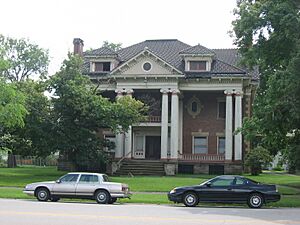
The North Side has neighborhoods like Brier Hill, Crandall Park, North Heights, and Wick Park. Brier Hill was a cultural center. Many Welsh, Irish, Italian, and African American people settled there. It was known as the city's "Little Italy". The Brier Hill Fest happens every year in August. The historic Crandall Park neighborhood used to be home to the city's richest families. Many of their large houses are still there.
Youngstown's South Side is the most populated part of the city. Older neighborhoods like Oak Hill and Erie were settled early. Later, areas like Fosterville, Newport, and Lansingville grew as industry expanded. The South Side shares Mill Creek Park with the West Side.
The East Side is the largest area of the city. It includes communities like East High, Hazelton, and Lincoln Knolls. The neighborhoods closest to downtown were developed early. However, much of the East Side is undeveloped land. This land was added in the 1950s for future growth that did not happen.
The West Side has neighborhoods like Belle Vista and Cornersburg. These were built from the 1930s to the 1950s. The West Side also shares Mill Creek Park with the South Side. It is southwest of the Mahoning River.
Population Changes
| Historical population | |||
|---|---|---|---|
| Census | Pop. | %± | |
| 1820 | 273 | — | |
| 1830 | 384 | 40.7% | |
| 1840 | 654 | 70.3% | |
| 1850 | 2,802 | 328.4% | |
| 1860 | 2,759 | −1.5% | |
| 1870 | 8,075 | 192.7% | |
| 1880 | 15,435 | 91.1% | |
| 1890 | 33,220 | 115.2% | |
| 1900 | 44,885 | 35.1% | |
| 1910 | 79,066 | 76.2% | |
| 1920 | 132,358 | 67.4% | |
| 1930 | 170,002 | 28.4% | |
| 1940 | 167,720 | −1.3% | |
| 1950 | 168,330 | 0.4% | |
| 1960 | 166,689 | −1.0% | |
| 1970 | 139,788 | −16.1% | |
| 1980 | 115,427 | −17.4% | |
| 1990 | 95,787 | −17.0% | |
| 2000 | 82,026 | −14.4% | |
| 2010 | 66,982 | −18.3% | |
| 2020 | 60,068 | −10.3% | |
| 2023 (est.) | 59,108 | −11.8% | |
| U.S. Decennial Census | |||
Between 1960 and 2010, Youngstown's population dropped by over 60%. The Mahoning Valley metropolitan area had 541,243 residents in 2020.
Youngstown's Population in 2020
In 2020, Youngstown had 28,303 households. The population density was about 1770 people per square mile. The city's population was 47.8% White and 41.1% African American. About 7.4% were from two or more races. Hispanic or Latino people made up 10.9% of the population. The average household income was $30,129.
Youngstown's Population in 2010
In 2010, Youngstown had 26,839 households. The population density was about 1958 people per square mile. About 47.0% of the city's population was White. About 45.2% was African American. Hispanic or Latino people made up 9.3% of the population.
About 28.6% of households had children under 18. About 37.8% of households were single people. The average household size was 2.28 people. About 22.8% of the city's population was under 18. The average age was 38 years old.
Economy of Youngstown
Past Industries
Youngstown had a lot of coal and iron. It also had hardwood forests for making charcoal. This helped a strong steel industry grow. The first blast furnace was built in 1803. By the mid-1800s, Youngstown had several iron factories. Easy train connections helped the iron industry grow even when local resources ran out. In the early 1900s, factories started making steel. Many local companies joined larger national ones.
In the late 1930s, Youngstown's steel industry was in the news again. This was during the "Little Steel Strike." Workers tried to get contracts with smaller steel companies. On June 21, 1937, two people died and 42 were hurt during strike violence. Even with the violence, the strike helped workers' unions become stronger across the country.
From the 1920s to the 1960s, Youngstown was a major industrial center. It had huge furnaces and factories for companies like Republic Steel and U.S. Steel. But Youngstown's economy was not very diverse. It relied mostly on steel. So, when factories closed in the 1970s, the city had few other options. The closing of a large part of Youngstown Sheet and Tube on September 19, 1977, is called "Black Monday." It marked the end of the old steel industry in Youngstown.
After the steel plants closed, Youngstown lost about 40,000 factory jobs. Many other businesses also closed. The city lost a lot of income and tax money for schools. Youngstown is still working to recover from these job losses.
The car production plants in the area helped a little. In the late 1980s, the Avanti car was made in Youngstown. This car had a fiberglass body. It was designed to compete with the Corvette. This company later moved away. The General Motors Lordstown Assembly plant was a big employer for a long time. It was one of the nation's largest car plants. It made cars like the Chevrolet Impala and Cavalier. The Lordstown plant closed in March 2019. It is now owned by Foxconn.
Current Economy
The biggest employer in Youngstown is Youngstown State University (YSU). It is a public university with about 15,000 students. It is just north of downtown.
Youngstown still has some steel and metalworking companies. The largest industrial employers in the city are Vallourec Star Steel Company and Trivium Packaging. Steelite, a British company that makes ceramics, has its U.S. headquarters in Youngstown.
Youngstown's downtown area is now seeing new business growth. The Youngstown Business Incubator (YBI) helps new technology companies. It gives them office space and support. Some companies from the YBI have become very successful. One company, Turning Technologies, was named one of the fastest-growing software companies in the U.S. In 2014, the YBI was ranked the top university-associated business incubator in the world.
Many products and businesses that started in Youngstown became famous. These include Youngstown-based Schwebel's Bakery. It now sells bread products across the country. In the 1920s, the Good Humor ice cream brand started in Youngstown. Handel's Homemade Ice Cream & Yogurt also started there in the 1940s. In the 1950s, developer Edward J. DeBartolo Sr. built one of the first modern shopping centers in nearby Boardman. The fast-food chain, Arby's, opened its first restaurant in Boardman in 1964.
Culture and Entertainment
Fun Things to Do
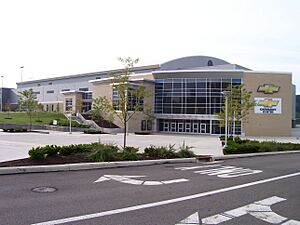
Even with economic challenges, Youngstown has many cultural and fun activities. Youngstown's newest place for entertainment is the Youngstown Foundation Amphitheatre. This outdoor venue opened in 2019. It is built on old industrial land downtown. It hosts many musicians and concerts.
One of the city's sports attractions is the Covelli Centre. This large, modern building opened in October 2005. It was built on the site of an old steel mill. The main team that plays there is the Youngstown Phantoms hockey team. They play in the United States Hockey League. The center also hosts ice shows and concerts.
In the past, a very popular place was Idora Park. This was an amusement park that operated from 1899 until 1984. It closed after a big fire destroyed many of its rides.
Theater and Music
The main cultural center is Powers Auditorium. This used to be a Warner Brothers movie theater. Now, it is the main music hall and home for the Youngstown Symphony Orchestra. This downtown building is one of five auditoriums in the city. Ford Recital Hall was added to Powers Auditorium in 2006. The grand Stambaugh Auditorium, on the north side, has hosted concerts for many years. It is also rented for private events. The Stambaugh Youth Concert Band plays there.
The Youngstown Playhouse is the main community theater in Mahoning County. It has been serving the area for over 80 years. It is thought to be one of the oldest continuously running community theaters in the country. The Oakland Center for the Arts used to be a well-known place for local plays. It closed in 2015 but reopened in late 2016. Now, it focuses on theater for young people and kids.
Famous actors and performers from the Youngstown area include Joe Flynn, Elizabeth Hartman, Maureen McGovern, and Ed O'Neill.
Museums to Explore

The Butler Institute of American Art is next to the Youngstown State University campus. It was started in 1919 by Joseph G. Butler Jr. It was the first museum in the U.S. dedicated to American art. Across the street is the McDonough Museum of Art. This is YSU's art museum and the main place for modern art in the Mahoning Valley. It shows changing exhibits by artists from the area and around the world.
The Arms Family Museum of Local History is just north of YSU. This museum is in a 1905 Arts & Crafts style mansion. It is run by the Mahoning Valley Historical Society. It shows rooms as they looked in the past, with original furniture and items. The museum also has changing exhibits about local history.
The Youngstown Historical Center of Industry and Labor is south of the YSU campus. This museum focuses on the Mahoning Valley's history of steel making. Other museums include the Children's Museum of the Valley. This is an interactive learning center downtown. The Davis Education and Recreation Center shows the history of Youngstown's Mill Creek Park.
On the city's north side, the Youngstown Steel Heritage Foundation is building the Tod Engine Heritage Park. It will show old steel industry equipment. The main exhibit is a 1914 steam engine. It was built in Youngstown and used in a local steel mill.
Parks and Recreation
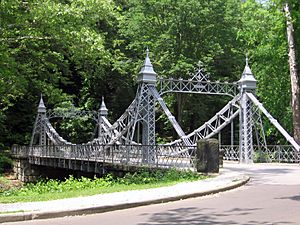
Youngstown's most popular natural spot is Mill Creek Park. It is a 5-mile (8 km) stretch of woods along Mill Creek. It is the oldest park district in Ohio, started in 1891. The park has a restored 19th-century Lanterman's Mill. It also has rock formations, nature trails, and the Fellows Riverside Gardens. You can also see the "Cinderella" suspension bridge and two golf courses. Mill Creek Park covers about 2,600 acres (10.5 km²). It has 20 miles (32 km) of roads and 15 miles (24 km) of walking trails.
Fellows Riverside Gardens has a great view. From one side, you can see the woods and Lake Glacier. From the other, you can see downtown Youngstown. The park has two 18-hole golf courses. There are also playgrounds, sports fields, and picnic areas.
In 2005, Mill Creek Park was added to the National Register of Historic Places. A plaque marks this event near a statue of Volney Rogers. He was the lawyer who set aside land for the park.
Wick Park is a smaller park on the city's north side. It is surrounded by large mansions built by wealthy people in the early 1900s. Stambaugh Auditorium is near the park. Crandall Park is another small park on the north side. It is surrounded by nice homes and tree-lined streets. There are also several cemeteries and small parks throughout the city. These include Homestead Park and John White Park.
Sports in Youngstown
| Club | League | Venue | Established | Championships |
|---|---|---|---|---|
| Mahoning Valley Scrappers | MLB Draft League, Baseball | Eastwood Field | 1999 | 1 |
| Youngstown Phantoms | USHL, Ice hockey | Covelli Centre | 2003 | 2 |
Youngstown has a long history of professional and semi-professional sports. The Mahoning Valley Scrappers baseball team plays at Eastwood Field. They are part of the MLB Draft League. The Youngstown Phantoms hockey team plays at the Covelli Centre. They are part of the United States Hockey League. A local amateur soccer club, Mahoning Trumbull United SC, started playing in 2023.
In earlier years, the city had many minor league baseball teams. These included the Youngstown Ohio Works and the Youngstown Steelmen. Baseball was so popular that the city hosted championship games in the 1930s and 1940s. There were also semi-professional football teams. The Youngstown Patricians won a championship in 1915.
Youngstown has produced many famous athletes. These include boxing champions Greg Richardson, Harry Arroyo, and Ray "Boom Boom" Mancini. Other athletes include baseball player Dave Dravecky and football player Bernie Kosar.
Youngstown State Penguins
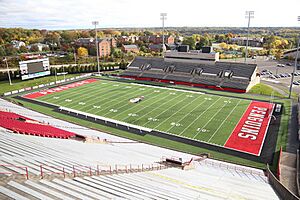
The city has a strong tradition of college sports. The Youngstown State Penguins play in the Missouri Valley Football Conference. Their football team plays at Stambaugh Stadium. All other YSU sports teams play in the Horizon League. The men's and women's basketball teams play at Youngstown State's Beeghly Center. The baseball and softball teams have also been successful. The baseball team reached the NCAA super-regionals in 2005. The softball team did so in 2006.
Education in Youngstown
Libraries and Schools
Youngstown has a public library system called the Public Library of Youngstown and Mahoning County. It has libraries in Downtown, Brownlee Woods, and other neighborhoods.
The Youngstown City School District runs all public schools in the city. Since 2015, the state government has helped manage the district. The high school graduation rate has improved a lot. It went from 65% in 2015 to 88% in 2020. The district has six elementary schools, three middle schools, and three high schools. It also has an alternative school and a technical school. Many new schools were built in the late 2000s. Older buildings were sold to private schools.
The city used to have eight public high schools. Now, there are four: Chaney High School, Choffin Career and Technical Center, East High School, and Youngstown Rayen Early College. The early college program works with Youngstown State University. It lets middle and high school students take college classes and earn credits.
The Diocese of Youngstown used to oversee over 20 Catholic schools. Now, only four Catholic schools are in Youngstown. These include two primary schools and two high schools. Many other Catholic schools in the region accept students from Youngstown.
Youngstown also has a few private schools. These include Valley Christian School, a K-12 nondenominational school. Akiva Academy is a K–8 school in the Jewish Community Center. The Montessori School of the Mahoning Valley offers different learning styles for students from preschool to eighth grade. There are also smaller charter schools like Stambaugh Charter Academy.
Colleges and Universities

Youngstown State University is the main college in the Youngstown–Warren area. It started as a YMCA program offering college classes in 1908. YSU became part of Ohio's higher education system in 1967. It has about 11,000 students. The campus is just north of downtown. It is also south of Youngstown's historic Fifth Avenue district. This area has homes built in Tudor, Victorian, and Spanish Colonial Revival styles.
Eastern Gateway Community College had a campus in downtown Youngstown from 2009 to 2024.
Media and News
Newspapers and Magazines
The Vindicator is the only daily newspaper in the city. It is now published as a section of Warren's Tribune Chronicle. In June 2019, it was announced that the old Vindicator would stop publishing. The new version has less coverage and fewer journalists.
Other newspapers printed in Youngstown include the bi-monthly The Business Journal. There is also The Metro Monthly. The Jambar is a bi-weekly paper published by students at Youngstown State University.
TV Stations
Youngstown has about 273,480 homes with televisions. This makes it the 106th largest TV market in the country.
The area has four main TV stations:
- WFMJ-TV (channel 21, NBC, with The CW on channel 21.2)
- WKBN-TV (channel 27, CBS)
- WYTV (channel 33, ABC, with MNTV on 33.2)
- WNEO (channel 45, PBS)
Low power station WYFX-LD (channel 62) is Youngstown's Fox channel. It is also shown on WKBN 27.2.
Radio Stations
Youngstown has many radio stations, both AM and FM.
- AM Stations:
- 570 WKBN Youngstown (News/talk)
- 600 WRQX Salem (Conservative talk)
- 790 WPIC Sharon, PA (Talk radio)
- 830 WKTX Cortland (Urban contemporary gospel)
- 1240 WBBW Youngstown (Sports - Infinity)
- 1280 WUZZ New Castle, PA (Classic country - WYLE simulcast)
- 1330 WGFT Campbell (Urban contemporary)
- 1390 WNIO Youngstown (Sports)
- 1440 WHKZ Warren (Catholic - Relevant Radio)
- 1470 WLOA Farrell, PA (Hip-hop)
- 1540 WYOH Niles (Talk)
- 1570 WHTX Warren (Talk)
- FM Stations:
- 88.5 WYSU Youngstown (NPR)
- 89.5 WILB Boardman (Catholic)
- 90.7 WKTL Struthers (Adult album alternative - WAPS semi-satellite)
- 91.7 WYTN Youngstown (Christian - Family Radio)
- 93.3 WNCD Youngstown (Classic rock)
- 95.1 WYLE Grove City, PA (Classic country)
- 95.9 WAKZ Sharpsville, PA (Mainstream urban)
- 98.9 WMXY Youngstown (Adult contemporary)
- 101.1 WHOT Youngstown (Contemporary hit radio)
- 101.7 WYLR Hubbard (Contemporary Christian - K-LOVE)
- 102.9 WYFM Sharon, PA (Classic rock)
- 103.9 WWIZ West Middlesex, PA (Oldies)
- 105.1 WQXK Salem (Country)
- 106.1 WBBG Niles (Country)
Transportation in Youngstown
Getting Around the City
The Western Reserve Transit Authority (WRTA) bus system serves the Youngstown area. Its main station is downtown. WRTA buses travel throughout the city and into nearby counties. The downtown station is also Youngstown's Greyhound bus terminal.
Air Travel
The Youngstown-Warren Regional Airport is the main airport for the region. As of 2022, no commercial airlines fly from this airport. It is home to the Youngstown Air Reserve Station. Smaller airports for private planes include Lansdowne Airport and Youngstown Elser Metro Airport.
Train Services
Near the WRTA terminal is an old Baltimore and Ohio Railroad station. This historic building served trains until 1971. It is now a banquet hall. It was a stop for Amtrak's Three Rivers train from 1995 to 2005. The closest Amtrak service now is the Capitol Limited train. It stops at Alliance station, about 42 miles (68 km) away. Freight trains still use lines owned by CSX Transportation, Norfolk Southern Railway, and the Youngstown and Southeastern Railroad.
On June 23, 2016, Uber started offering services in Youngstown. It covers all of Mahoning County and most of Trumbull County.
Sister Cities
 Spišská Nová Ves, Slovakia, since 1991
Spišská Nová Ves, Slovakia, since 1991
See also
 In Spanish: Youngstown (Ohio) para niños
In Spanish: Youngstown (Ohio) para niños


